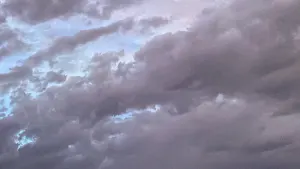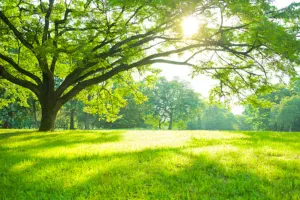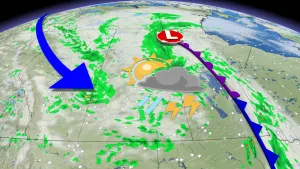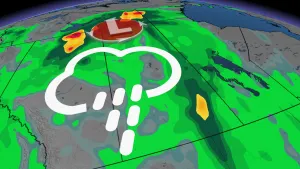
Salt burn: The invisible cause behind your 'dead' plants
Living near the ocean? Salt burn could be problematic to your plants
The damage to the boardwalk in Eastern Passage is still plain to see after storm surge from post-tropical storm Lee ripped sections of it apart. The trained local eye will also notice that the plants and leaves in the area have shrivelled up and become discoloured earlier than normal.
You can see the ocean from Nicole Gallant’s front yard in the Eastern Passage. After the storm hit, many of the plants in her garden turned brown.
“It kind of looks like it’s dead, but it’s not. It’s just been burned so badly by the salt,” Gallant tells The Weather Network while pointing out the salt-burnt plant.

Plants dried up due to salt burn in Nicole Gallant's front yard in Eastern Passage, N.S. (Nathan Coleman/The Weather Network)
She was outside as winds from post-tropical storm Lee blanketed her coastal neighbourhood with salt.
“When you walked a little closer to the water, it felt like it was raining, but when I walked up my driveway, you could literally taste the salt off your lips. That's how salty it was that morning," says Gallant.

Usually, salt burn appears on plants' tips and/or margins. (Nathan Coleman/The Weather Network)
Halifax’s Urban Forestry supervisor Kevin Osmond says it doesn’t matter what you plant. When you have high winds and high tide at the same time, you can’t escape salt burn.
“I’m seeing a lot of salt burn and a little bit of wind burn on deciduous trees on those leaves that even right after the storm the trees looked fine. But now, given a week or two after the storm, the edges of the leaves are looking burnt,” Osmond explains.

The plant can appear dead, but it's not. It's just been burnt so bad by the salt. (Nathan Coleman/The Weather Network)
Salt may be washed away in the aftermath of a storm with heavy rains, but given the current dry spell, there's no telling when that will happen.
“It just sort of collects in the atmosphere somewhere—or in the lower level—drifts around with the wind, and just sticks to anything,” says Osmond.
Gallant is now harvesting from her backyard vegetable garden earlier than she had hoped.
“Once we get a salt burn, if you think of something like tomatoes, once you burn all the leaves off, you really have to harvest these tomatoes fast because now there’s nothing to really bring in the energy of the sun anymore because, as you can see, all the leaves are gone,” she says.
Further inland, fall colours are still expected on healthy leaves, though Osmand says not until later this season.










